Everything you need to know about etching
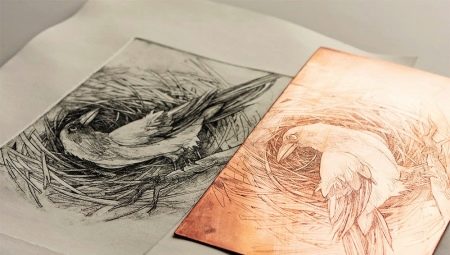
Etching is a type of easel engraving made in a special way. An image using the etching technique is obtained using an imprint from a ready-made cliche. The technique is based on a chemical process (exposure to a metal with nitric acid), and not a mechanical method of obtaining an image with special instruments. The technique refers to in-depth (gravure) printing of a pattern, that is, depressions along the contour of the pattern on a metal plate are filled with paint and transferred to paper using a special machine.

An impression from one cliche can be done many times, therefore etching is the most convenient method of engraving.
What is this and how did the technique arise?
Etching was first mentioned at the beginning of the 16th century, but it became widespread closer to the next century. The word "etching" comes from the French eau forte - strong water, meaning nitric acid, with which an impression is obtained. The technique appeared among jewelers and gunsmiths, where it was necessary to apply an image on metal.

For a long time, the etching technique was used only in icon painting. It was only in the 17th century that etching began to be used in art. Engravings of that time, obtained with the help of etching, are becoming a separate art form. Rembrandt used repeated etching to achieve high quality images with fine details and complex color transitions. Using etching, he made small sketches and sketches, turning the technique into a form of graphic art. The artists used different types of paper to create a unique result. By the end of the 18th century, etching began to be used in the printing house. In almost all books of that time, illustrations were made using this technology.The illustrations turned out to be picturesque and quite realistic. At the same time, it was quite inexpensive, and the forms were durable, which made them reusable.


The drawing is created on a metal board - on copper or zinc, sometimes steel is used. First, the board is cleaned, sanded and polished. Then it is slightly heated and varnished. A special acid-resistant composition is used for varnish. In the Middle Ages, rosin and a mixture of resin and wax were used. Later, they began to use a composition based on asphalt and wax. Modern craftsmen most often take a bituminous varnish solution. A form with a hardened coating is smoked; on a black background, the applied grooves will be better visible. A drawing is applied to the prepared form using etching tools. In this case, a layer of varnish is scratched to its full thickness, the etching needle should reach the metal itself, but not damage it. Then the board is treated with acid, which corrodes it only in places without a protective layer of varnish. Under the influence of acid, the metal is etched, depressions remain on it, which create a pattern when printed on paper or other surface. For zinc forms, nitric acid is used, and for copper forms, a solution of ferric chloride is suitable. After etching with an acidic composition, the board is washed, the varnish layer is cleaned, and the deeper outlines of the applied image remain on the surface.

The varnish is removed from the plate using turpentine or gasoline.
To obtain an impression, paint is applied to the finished cliche. Its excess is removed with a special spatula or sponge. Then the drawing is transferred to paper or fabric.

Drawings created using the etching technique can be very complex with color transitions or penumbra and shaded areas. A distinctive quality of the technique is the possibility of stepwise etching. After applying the image, the master performs a test print, then repeats the operation with a protective varnish, scratching the pattern and etching. Thus, the craftsmen achieve the smallest elaboration of details and the perfect result. After a few etchings, the copper or zinc board is ready for further use and can be used to print impressions.

Each print is considered a separate work of art, as it has slight differences. Rembrandt, who often used etching for his engravings, left several copies of the same painting. The prints were made at different stages of etching and differ from one another. Each of them has its own value and uniqueness.

By increasing the etching time, the craftsmen vary the depth of the strokes, and subsequently the depth of tone in the painting. Craftsmen use a special step-etch timeline where they note the etching time of the mold. Sometimes already etched areas are varnished, while others are etched again. This is done to create deeper grooves so that the color in the print is darker.

When making boards, it must be borne in mind that with repeated and constant use of the form, the smallest details are erased, and the print becomes not so detailed. The finest lines, strokes and dots are erased over time and do not leave an impression of the original quality. Such boards are no longer of high value and require restoration.

Iron molds are more durable and withstand a significant number of runs, while zinc and copper boards are softer.
Manners and techniques
In the etching technique, there are several ways of performing strokes and lines on a plate (board) obtained by etching. The most common of these is the etched stroke, sometimes it is called the classic, line or needle. In work, it is often combined with other etching techniques, for example, with aquatint and lavis.

The advantage of etching over other types of engraving techniques is the relative simplicity and ease of work. No significant physical effort is required to create an engraving.The master can make strokes and lines in any convenient direction, creating a unique pattern on the plate. With acid etching, the strokes are corroded not only in depth, but also slightly in width. This makes the drawing three-dimensional. Some etching masters achieved the effect of chromaticity, using different manners and techniques in the manufacture of forms for printing. Small shallow strokes and lines seem lighter and recessed into the etching paper, while deep ones, on the contrary, appear on the surface and have a dark deep color. Carved metal forms for engravings are made by the master artists themselves.



Manufacturing (especially etching) requires care and attention. Acids and their vapors used for pickling are poisonous.
The etching technique also allows for colored engravings. There are several options for obtaining color engraving. In the first attempts to do this, different parts of the form were covered with different colors, and printed. Later, they began to use several boards with the same image. Each board was painted in one color, when superimposed on each other, they gave a color image. Some craftsmen hand-paint the plate and then make an impression. Sometimes a black print is made for the background first, and then a color image is superimposed. When receiving art reproductions, the masters tint the print itself, and not just the form.

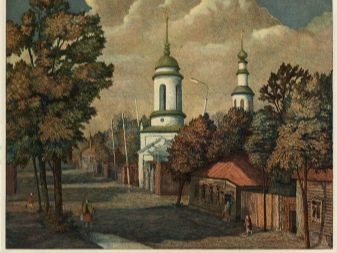
Etched stroke
The main technique of etching, which has collected all the characteristic features of the technique. Every etching artist must first of all master this style, and only then develop his skill. A special etching needle is used to apply a pattern to the board with an etched stroke. Steel etching needles are available in various diameters. Sometimes craftsmen use bundles of needles or metal brushes. Then the mold is etched and a test impression is made. Draw on a plate with a needle like a pencil on paper. Craftsmen use different pressure forces to obtain different depths of the contour of the drawing.


Aquatint
A more sophisticated technique in etching, which allows you to achieve a soft color transition. Engravings in this manner are similar to watercolors. At first, only the contour of the future drawing is applied to the form, then the board is etched. Places where the print should be dark are covered with asphalt or rosin, which, when heated, leave roughness. And bright places are covered with a protective varnish. The board is then heated and re-etched. Aquatint is often used in conjunction with classic etching, as well as in color printing.


Reserve
A relatively new style in etching. It originated from a mixture of aquatint and etched strokes. A distinctive feature of this technique is painting with a brush directly on a prepared metal plate. To do this, use a fiberglass brush and special ink or gouache. A varnish is applied over the image and the plate is washed with plain water. Under the influence of ink (gouache) and water, the places to be etched are exposed with the utmost precision. The manner of reserve allows you to preserve the individual characteristics of the author's drawings and the technique of artists.


Lavis
For this technique, rosin is sprayed onto the mold. The metal plate is heated and the rosin powder is melted. On top of it, an image is applied with a brush using an etching solution of acid, gouache and glue. After that, the mold is washed well. Such manipulations can be repeated to achieve the desired result. Lavis engravings have a soft outline similar to watercolor paintings.


Soft varnish
Another style is sometimes called tear-off varnish. The technique is simple and does not require special skills from the master etcher. Reception consists in adding fat (lard) to acid-resistant varnish. Because of this, the etching soil becomes soft and easily comes off the plate. When drawing strokes, coarse-grained paper is applied to the form.With a blunt pencil, a drawing (or pattern) is applied using different pressure forces. In places of pressure, the paper sticks to the varnish. Together with the paper, the varnish is easily separated from the mold. The mold is etched and the remaining soil is removed. A grainy pattern remains on the board. These prints are like pencil sketches.


Dry needle
The technique is sometimes viewed as a separate engraving technique. But nevertheless, it is more correct to attribute it to etching techniques. In this technique, acids and etching compounds are not used to apply the contour to the mold. The image is applied directly to the metal surface with a sharp needle. Therefore, the method was called dry needle. Here, the beauty of an engraving depends entirely on the skills and talent of the master. Dry needle is often combined with other techniques.
Engravings in the drypoint technique in combination with aquatint or lavis look spectacular.
Dry needle requires physical strength from the master. This style is characterized by straight lines and strokes. Smooth and intricate patterns are difficult to draw with a metal needle. Drypoint is often used to refine prints made with classic etching or chisels.


Mezzotint
One of the most laborious etching techniques. But engravings created in this manner look very impressive... The trick is to create a grain effect on the plate. This is achieved by applying a large number of the smallest indentations and roughness. They give a smooth transition from light to dark tones, creating a partial shade effect. Mezzotinto engravings are distinguished by their richness of shades and halftones. Mezzotinto is called the "black manner" of etching, due to the predominance of dark tones in the engravings. The drawing is created with skillfully selected light colors on a dark background.

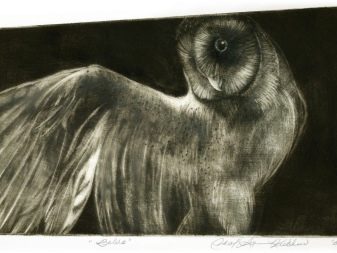
Pencil manner
The technique came from a combination of an incisor style with a classic etching. After the first drawing on the mold in the classical manner and etching, the lines are deepened using the dry point method. After this technique, the strokes of the print become wide and thick. The lines are similar to an Italian pencil or even a sanguine. Pencil style was used to recreate existing drawings.


Dotted manner
The technique is to create a picture using dashes, dots or small strokes. The depth of color and midtones are achieved with different depths and sizes of dots, their crowding or, conversely, spread. The dots are applied with various tools to the primed plate, which is later etched. At first, the dotted line technique was characteristic only for incisor engraving, but then it was adopted by the master etchers. The manner is more often used in reproductive etching.

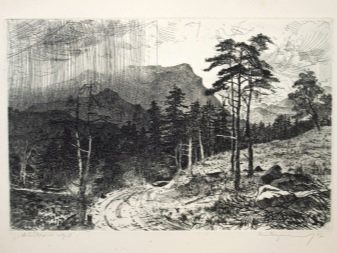
Incisal engraving
The very first type of metal engraving. It does not use etching agents, but applies the pattern directly to the metal. To do this, use a special tool - a cutter (shtikhel). After drawing the pattern, the board is thoroughly cleaned, removing all irregularities, shavings and roughness. The board can then be used for a proof print.


Notable masters
The first famous artist to use etching in his works was Albrecht Durer. It was he who began experimenting with various metals and acids in the manufacture of forms for engravings.






In his works, Dürer skillfully combined classical engravings with etching.
The Italian artist Parmigianino, and later Rembrandt, created inimitable masterpieces in the technique of etching. They achieved the play of color and shadow using step etching.



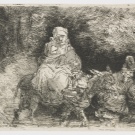


The French painter Jean-Baptiste Leprinse in 1765 discovered a new technique in the technique of etching. The technique is called aquatint, it helps to create halftones, reminiscent of a watercolor painting. And the unsurpassed master in this manner was the etching painter Francisco Goya.




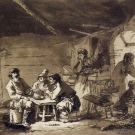

Even Salvador Dali tried his hand at etching. In this technique, he performed his famous series of engravings "Five Immortal Spaniards".

Iconographers became the first etchers in Russia. The very first impression using the etching technique was made by the famous icon painter Simon Ushakov. Later, almost all graphic artists tried their hand at etching. In St. Petersburg, a society of etchers was even founded in 1871, which included the famous I. Shishkin and I. Repin, V Mate and many other artists.




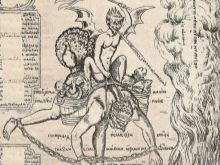
In Soviet times, engraving and etching began to be taught at the Moscow Polygraphic Institute. And in the 60-70s of the last century etching experienced a revival, graphic artists V. Yankilevsky, E. Neizvestny, D. Plavsky, G. Basyrov, G. Zakharov, V. Zvontsov began to study it. In the technique of etching, illustrations were often performed in books and other typographic publications.




The technique is still popular today. The engravings are distinguished by their special style and grace, velvety strokes and elaboration of details.



